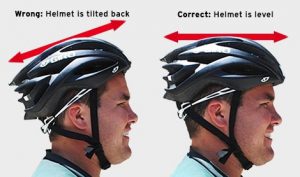
A bike helmet should be a no brainer. Once you get used to wearing one, it almost feels weird if you don’t wear one! While all helmets will protect your head, some are designed with aerodynamics in mind, some are exceptionally lightweight and others provide maximum ventilation at high speeds. As price increases, helmets are typically lighter in weight and have more vents.
Biking Helmet Types
- Sport helmets: Perfect for multi-use recreation, sport helmets are an economical choice for cruising the bike path, commuting, casual road and mountain biking.
- Road bike helmets: With low weight, generous ventilation and aerodynamic design, road bike helmets are preferred by serious road bike enthusiasts.
- Mountain bike helmets: Mountain bike helmets are designed to ventilate well at low speeds and are often distinguished by small visor. They have enhanced rear-head coverage and a firm and a secure fit for tackling rough terrain. Mountain bike helmets are often used by cyclocross riders, too.
Bike Helmet Sizing 
It’s crucial to select a helmet that fits comfortably and securely. A properly fitted helmet will move the eyebrows when tilted forward and backward. If there’s a gap, it’s too big.
Grab a tailor’s tape measure. You know, the floppy ones used for sewing (not the one from your tool box). Measure the largest portion of your head, about 1 inch above the eyebrows. Use the general sizing parameters below to find your helmet size. Most helmets can be micro adjusted to account for various shaped heads, so once you receive your helmet, you can dial in a perfect fit.
- Small: 20″-21.75″ (51cm-55cm)
- Medium: 21.75″-23.25″ (55cm-59cm)
- Large: 23.25″-24.75″ (59cm-63cm)
- Extra-small, extra-large: Below 20″ (51cm), above 24.75 (63cm)
- One size fits all (men): 21.25″-24″ (54cm-61cm)
- One size fits all (women): 19.75″-22.5″ (50cm-57cm)
Bike Helmet Specs
Compare the specs of various helmets using the guide below. Determine which attributes are most important or most relevant to your style of riding.
- Weight: Weight is almost always listed in grams (28.34g = 1 oz.). Racers and frequent cyclist will appreciate the weight savings of a lighter helmet. For occasional cyclist, weight is not a big concern. The lighter the helmet, the more expensive.
- Vents: Vents are designed to create airflow around and over your head and will cool the head. The more vents, the pricier the helmet.
- Visor: Some riders prefer having a sun-shielding visor attached to their helmet. On the flip side, it adds a fractional ounce of weight and slight wind resistance.
- Fit system: Manufacturers create a variety of names (e.g., Roc Loc, GPS, Acu-Dial) to represent their approach to a helmet’s sizing wheel (typically a dial). Be sure to visit the manufacturer’s website for a detailed explanation.
Shop for bike helmets at The-House.









[…] tips for selecting a good helmet include selecting a helmet that sits above the eyebrow line and doesn’t make contact with the […]